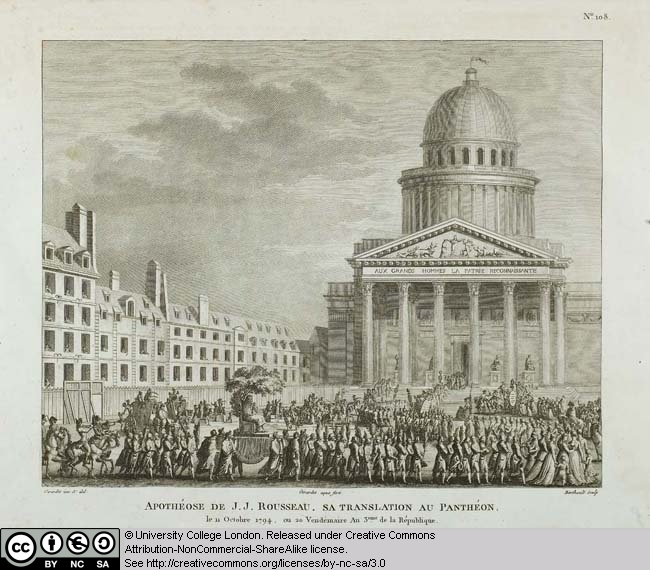
Pierre Gabriel
Berthault (1748 – 1819) after Abraham Girardet (1764 – 1823)
Apothéose de J.J.
Rousseau. Sa Translation au Panthéon. Le 11 Octobre 1794, ou 20 Vendémaire an
3eme de la République (Apotheosis of J.J. Rouseau. His removal to the Pantheon.
11th October 1794, or 20 Vendémaire, 3rd year of the Republic) , 1798
Etching and Engraving
Published in the
series Tableaux historiques de la Révolution française, 1791 – 1817, ( first
included in the edition of 1798 )
A notable characteristic of the Tableaux historiques series
is the topographical accuracy with which the settings for events are rendered.
In this case Giradet’s accuracy can be measured against the building of the
Pantheon, whose dome still dominants the Paris
skyline today. In other instances the prints are rendered doubly interesting to
architectural historians because they remain valuable records of places long
since demolished: the Abbey prison, for example, was destroyed in 1854. Yet the
artists involved with the project were not above the subtle manipulation of
their settings for artistic or ideological effect. In this instance the size of
the Pantheon is accentuated by the way Giradet has aligned different elements
such as the statue of Rousseau in the foreground on the same axis as the flag
fluttering from the dome so that it the building looms majestically over the
foreground scene, and is endowed with an air of grandeur and authority. The
skyline drops the nearer it gets to the Pantheon building, which seems all the
more massive as a result.
In 1791 Soufflot’s church of Saint Geneviève
had been secularised and re-dedicated to the memory of Great Men. The
inscription added to the pediment at this point (and legible in Girardet’s
design) reads, ‘Aux Grands Hommes La Patrie Reconnaisante’ – ‘To Great Men, the
Fatherland is Grateful’. ’ During the Revolution, a number of
‘Pantheonisations’ were planned, including that of the revolutionary ‘martyrs’
Le Pelletier, Marat, and Bara, (although, because remains could only be
translated to the Pantheon ten years after death, none of these were actually
carried out). In this instance it is Jean-Jacques Rousseau who is accorded the
singular honour of being pantheonised, an event that took place with much
fanfare on the 11th October 1794. This print bears witness to the elaborate
ceremony that surrounded such an occasion and the huge number of people
involved: we see a procession snaking its way to the massive doors of the
Pantheon. Typically the communal ceremonies and festivals that punctuated the
French revolutionary calendar looked to the world of classical antiquity for
visual and ideological inspiration. In this instance note the classical dress
worn by those bearing the model of Rousseau seated in the shade of a tree or
the Roman-inspired standards carried by others in the procession.
